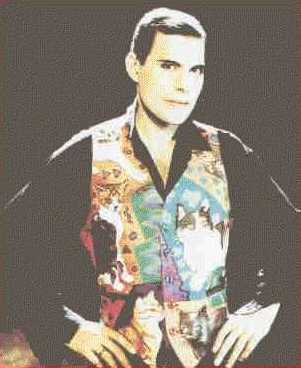Freddie Mercury
 Freedie Mercury was the bands lead singer. He tragicly died of AIDS in 1991, one day after he told the world of his illness.
Freedie Mercury was the bands lead singer. He tragicly died of AIDS in 1991, one day after he told the world of his illness.
The life of Frederick Bulsara began on the East African island of Zanzibar
on September 5, 1946. 25 years later in London under the name Freddie Mercury he
was fronting he now legendary rock group named Queen
The son of Bomi and Jer Bulsara, Freddie spent the bulk of his childhood in
India where he attended St.Peter's boarding school., near Bombay. It was during
his time there that the headmaster of the school realized that Freddie had
musical talent and sugge sted piano lessons to his parents. He began them at the
age of seven. He was also involved with the schools theatre and choir. It was at
St.Peter's that Freddie formed his first band, the Hectics. No one could foresee
where a love of music would take him.
The Bulsara family moved to Middlesex in 1964, due to political unrest in
their country In 1966, he enrolled in Ealing College of Art to study graphic
illustration. From there Freddie joined up with a blues band called
Wreckage while studying grap hic design courses at Ealing College of Art.
While singing for Wreckage, a fellow student, Tim Staffell, introduced
Freddie to Roger Taylor and Brian May, founder members of a band called
Smile. Watching Smile made Freddie realize that he really wanted to be in
a band himself, so after he finished his diploma in graphic art and design, he
joined a band called Ibex, taking over lead vocals from their guitarist. Smile
metamorphosed into Queen when Freddie joined Roger and Brian to start a new band
with himself as the lead vocalist. The f inal member of the band, which was to
stay together for the next 20 years was bassist John Deacon.
The rest is rock history. EMI Records promptly signed the band and in 1973
their debut album Queen was released and hailed as one of the most
exciting developments ever in rock music.
The immortal operatically styled single Bohemian Rhapsody was released
in 1975 and proceeded to top the UK charts for 9 weeks. A song that was nearly
never released due to its length and unusual style but which Freddie insisted
would be played beca me the instantly recognisable hit. By this time Freddie's
unique talents were becoming clear, a voice with a remarkable range and a stage
presence that gave Queen its colourful, unpredictable and flamboyant
personality.
Queen was always indisputably run as a democratic organisation. All four
members are each responsible for having penned number one singles for the band.
This massive writing strength combined with spectacular lights, the faultless
sound, a sprinkling of t heatricality and Freddie's balletic movements made up
Queen on stage and on film.
Through Freddie's ability to project himself and the band's music and image
to the four corners of 70,000 seater venues they became known as the prime
developers of stadium rock, a reputation perpetuated by their pioneering tactics
in South America where they performed to 231,000 fans in Sao Paulo, a world
record at the time. They also became known as the key innovators of pop videos
as their catalogue of 3 minute clips became more and more adventurous in style,
size and content.
In the mid 80s, Freddie started concentrating on his solo career which was to
run in tandem with Queen ("the mothership") for several albums, commencing with
the 1985 release of Mr Bad Guy. Freddie's much loved sense of self parody
reached a zenith with his cover version of The Platter's song The
Great Pretender in 1987, the video of which recorded him descending a
sweeping staircase among acres of identical cardboard cut-outs of himself.
His first major collaboration outside Queen was withDave Clark for the
recording of London's West End musical Time. This was followed in 1987
with the realisation of one of Freddie's long term dreams; to record with the
world revered opera d iva Montserrat Caball�. The LPs title song
Barcelona went on to become an anthem for Senora Caball�'s home city and
the theme for the Olympics in 1992.
Freddie returned to the studios to record Innuendo with Queen in 1990.
On November 24th 1991 (approximately 7pm London time) Freddie's struggle
against AIDS ended when he passed away just over 24 hours after he had publicly
announced he had the disease. No one knows exactly how long Freddie knew he had
the AIDS virus since h e didn't tell anyone, even the band, for a long time.
Some people have estimated about five years. Musicians and fans from all over
the world paid their highest respects as the passing of rock music's most
innovative, flamboyant ambassador signified the end of an era.
Freddie's house is at 1 Logan Place in Kensington, London. There is a wall
around the property, and it is now the home of Mary Austin, so you can only see
the outside of the property. The wall with all the graffiti that is seen in the
Champions of the Wor ld video is Freddie's house. (p> Freddie was cremated,
rather than buried, and there is no gravesite to visit. It is most likely that
his parents have his ashes.
Freddie Mercury, who majored in stardom while giving new meaning to the wortd
showmanship left a legacy of songs which will never lose their stature as
classics to live on forever.